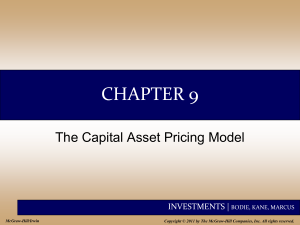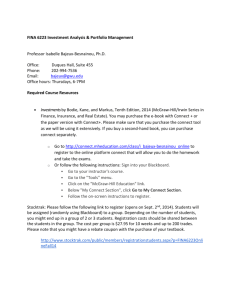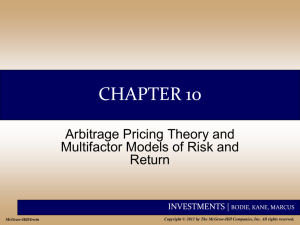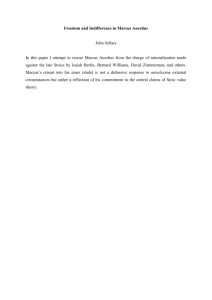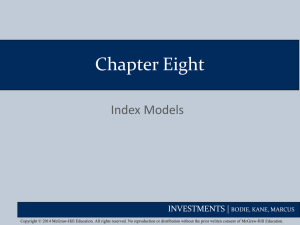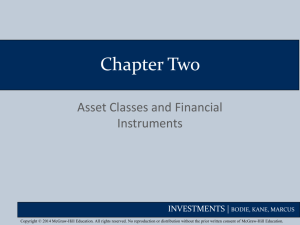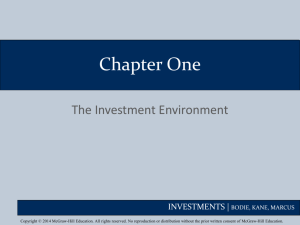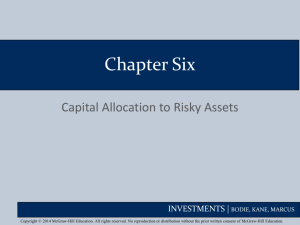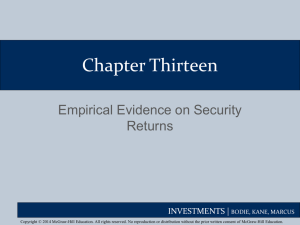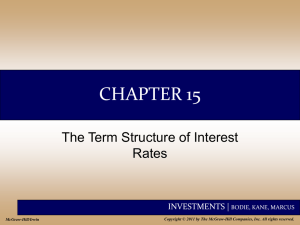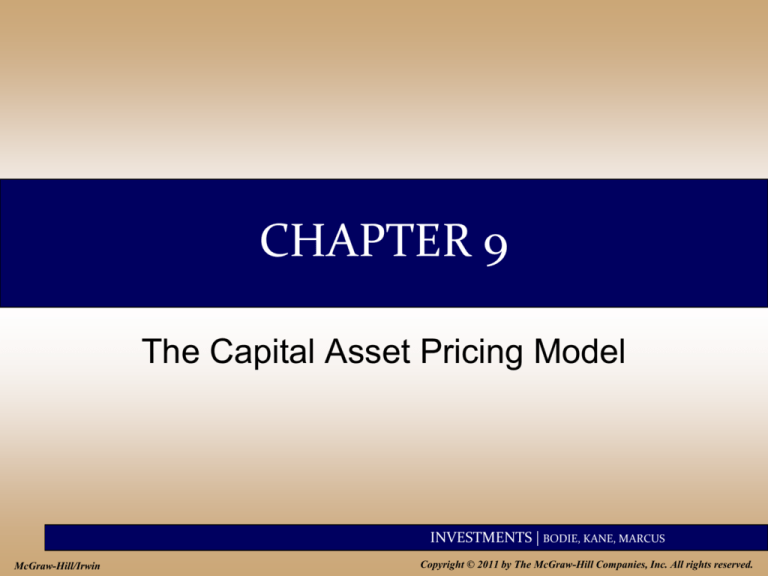
CHAPTER 9
The Capital Asset Pricing Model
INVESTMENTS | BODIE, KANE, MARCUS
McGraw-Hill/Irwin
Copyright © 2011 by The McGraw-Hill Companies, Inc. All rights reserved.
Capital Asset Pricing Model (CAPM)
• It is the equilibrium model that
underlies all modern financial theory
• Derived using principles of
diversification with simplified
assumptions
• Markowitz, Sharpe, Lintner and
Mossin are researchers credited
with its development
INVESTMENTS | BODIE, KANE, MARCUS
9-2
CAPM - Assumptions
• Individual investors
are price takers
• Single-period
investment horizon
• Investments are
limited to traded
financial assets
• No taxes and no
transaction costs
• Borrow at 𝑟𝑓
• Information is
costless and
available to all
investors
• Investors are
rational meanvariance optimizers
• Expectations are
homogeneous
INVESTMENTS | BODIE, KANE, MARCUS
9-3
Resulting Equilibrium Conditions
• The market portfolio (M) is on the
efficient frontier and is on the Capital
Market Line
• All investors will hold the same portfolio
for risky assets – market portfolio (M)
• Market portfolio contains all securities
and the proportion of each security is its
market value as a percentage of total
market value
(total market value = total wealth)
INVESTMENTS | BODIE, KANE, MARCUS
9-4
Resulting Equilibrium Conditions
• Risk premium on the market depends
on the average risk aversion of all
market participants
• Risk premium on an individual security
is a function of its covariance with the
market
INVESTMENTS | BODIE, KANE, MARCUS
9-5
Figure 9.1 The Efficient Frontier and the
Capital Market Line
INVESTMENTS | BODIE, KANE, MARCUS
9-6
Market Risk Premium
The risk premium on the market portfolio will be
proportional to its risk and the degree of risk
aversion of the investor:
E rM rf A
2
M
Where
2
• 𝜎𝑀
= variance of the Market portfolio
• 𝐴 = average degree or risk aversion
Q. Where does this formula come from?
INVESTMENTS | BODIE, KANE, MARCUS
9-7
Return and Risk For Individual Securities
• The risk premium on individual
securities is a function of the individual
security’s contribution to the risk of the
market portfolio.
• An individual security’s risk premium is a
function of the covariance of returns with
the assets that make up the market
portfolio.
• Why bother doing security analysis?
INVESTMENTS | BODIE, KANE, MARCUS
9-8
GE Example
• Covariance of GE return with the market
portfolio:
n
n
Cov(rGE , rM ) Cov rGE , wk rk wk Cov(rk , rGE )
k 1
k 1
• Therefore, the reward-to-risk ratio for
investments in GE would be:
GE's contribution to risk premium wGE E (rGE ) rf E (rGE ) rf
GE's contribution to variance
wGE Cov(rGE , rM ) Cov(rGE , rM )
INVESTMENTS | BODIE, KANE, MARCUS
9-9
GE Example
• Reward-to-risk ratio for investment in market
portfolio:
Market risk premium E (rM ) rf
Market variance
M2
• At equilibrium all reward-to-risk ratios are
equal, including that of GE:
E rGE rf
CovrGE , rM
E rM rf
2
M
INVESTMENTS | BODIE, KANE, MARCUS 9-10
GE Example
• The risk premium for GE:
E rGE rf
COV rGE , rM
2
Er r
M
f
M
• Restating, we obtain:
E rGE rf GE E rM rf
INVESTMENTS | BODIE, KANE, MARCUS 9-11
Expected Return-Beta Relationship
• CAPM holds for the overall portfolio because:
𝐸[𝑟𝑃 ] =
𝑘
𝑤𝑘 𝐸[𝑟𝑘 ]
and
𝛽𝑃 =
𝑤𝑘 𝛽𝑘
𝑘
• This also holds for the market portfolio:
𝐸[𝑟𝑀 ] = 𝑟𝑓 + 𝛽𝑀 [𝐸[𝑟𝑀 ] − 𝑟𝑓 ]
(remember 𝛽M = 1)
INVESTMENTS | BODIE, KANE, MARCUS 9-12
Fig. 9.2 The Security Market Line (SML)
INVESTMENTS | BODIE, KANE, MARCUS 9-13
Figure 9.3 The SML and a Positive-Alpha Stock
INVESTMENTS | BODIE, KANE, MARCUS 9-14
The Index Model and Realized Returns
• CAPM is based on expected returns:
E ri rf i E rM rf
• To move from expected to realized returns,
use the index model in excess return form:
Ri i i RM ei
• Observe that index model beta is the same
as the beta of the CAPM (quick derivation)
• Compare the two: should 𝛼 be zero?
INVESTMENTS | BODIE, KANE, MARCUS 9-15
Figure 9.4 Estimates of Individual Mutual
Fund Alphas, 1972-1991
• CAPM: E[𝛼𝑖 ] = 0 ∀𝑖
• index: realized 𝛼 should average to zero
Mean < 0 (slightly)
but statistically
indistinguishable
from zero
INVESTMENTS | BODIE, KANE, MARCUS 9-16
Is the CAPM Practical?
• CAPM is a good model to explain
expected returns on risky assets. This
means:
–Without security analysis, 𝛼 is
assumed to be zero
–Positive and negative alphas are
revealed only by superior security
analysis
INVESTMENTS | BODIE, KANE, MARCUS 9-17
Is the CAPM Practical?
• CAPM assumes the market portfolio M
is mean-variance optimal.
• Must use a proxy for market portfolio
(for example, but not limited to, S&P500)
• CAPM is still considered the best
available description of security pricing
and is widely accepted
(i.e. assume 𝛼=0 w/out analysis)
INVESTMENTS | BODIE, KANE, MARCUS 9-18
Is the CAPM Testable?
Empirical tests reject hypothesis 𝛼=0
Low 𝛽 securities have 𝛼 > 0
High 𝛽 securities have 𝛼 < 0
Is CAPM then not valid?
No better model out there, we measure
𝛼 and 𝛽 with unsatisfactory precision
• No mutual fund consistently outperforms
the passive strategy
•
•
•
•
•
INVESTMENTS | BODIE, KANE, MARCUS 9-19
Econometrics and the Expected Return-Beta
Relationship
• Are empirical tests poorly designed?
• Statistical bias is easily introduced
• Miller and Scholes paper demonstrated
how econometric problems could lead
one to reject the CAPM even if it were
perfectly valid
• For example residuals are correlated
within the same industry
INVESTMENTS | BODIE, KANE, MARCUS 9-20
Extensions of the CAPM
• Zero-Beta Model
– Combine frontier-portfolios to obtain
portfolios also on the efficient frontier
– Uncorrelated pairs of top and bottom
efficient frontier portfolio
– Helps explain 𝛼>0 for low 𝛽 stocks and
𝛼<0 on high 𝛽 stocks
• Consideration of labor income and nontraded assets (e.g. private equity)
INVESTMENTS | BODIE, KANE, MARCUS 9-21
Extensions of the CAPM
• Merton’s Multiperiod
• Consumption-based
Model and hedge
CAPM (Rubinstein, Lucas,
Breeden)
portfolios (ICAPM)
• Investors allocate
• Incorporation of the
wealth between
effects of changes in
consumption today
the real rate of
and investment for the
interest and inflation
future (future wealth
• K factors generalize
comes from
SML to Multi-index
investment and labor)
model
INVESTMENTS | BODIE, KANE, MARCUS 9-22
Liquidity and the CAPM
• Liquidity: The ease and speed with which an
asset can be sold at fair market value
• Illiquidity Premium: Discount from fair market
value the seller must accept to obtain a
(quick) sale.
– Measured partly by bid-asked spread
– As trading costs are higher, the illiquidity
discount will be greater
INVESTMENTS | BODIE, KANE, MARCUS 9-23
Figure 9.5 The Relationship Between
Illiquidity and Average Returns
INVESTMENTS | BODIE, KANE, MARCUS 9-24
Liquidity Risk
• In a financial crisis, liquidity can unexpectedly
dry up.
• When liquidity in one stock decreases, it
tends to decrease in other stocks at the same
time.
• Investors demand compensation for liquidity
risk
– Liquidity betas
INVESTMENTS | BODIE, KANE, MARCUS 9-25

